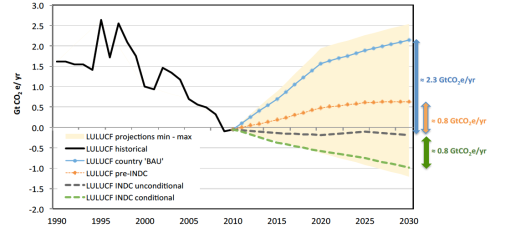by Simon Fischer*
In the end of last year, the world looked with promising eyes to Paris after the adoption of a presumably historic climate agreement had been announced. The given target of limiting the increase in global average temperatures to 2°C or even 1.5°C is seen by many as a victory but not much has been said about how to reach this. At a closer look, it becomes obvious that there is only a small chance of reaching the target. Recent studies point out that the implementation of the intended nationally determined contributions (INDCs) for global GHG reductions given by the countries would lead to an increase of 2.7 to 3.7C in global average temperatures rather than the desired 1.5°C. Moreover, some of the proposed “climate solutions” bring along major pitfalls. The studies used in the IPCC report for instance take into account negative emission scenarios, high risk technologies (e.g. BECCS) and extensive land use change (e.g. for monoculture plantations).
Last year, the EU announced its climate and energy targets which also form the basis of their INDC. The targets include GHG reductions of 40% and a share of at least 27% renewables until 2030. In order to reach their goal, land use and bioenergy have been set on top of the agenda in Brussels. Upcoming decisions on these issues will determine the EU’s post-2020 pathway, thus having major impact on the question whether the Paris agreement will lead to a real sustainable pathway or end up in hot air.
The land use sector (LULUCF) is of significant importance here. Uncertainties in monitoring and reporting emissions coming from the sector remain critically high. Its special and complex character (link) led to the fact that it has a special status in the UNFCCC accounting framework, so that its impact on the climate cannot easily be used to compensate the emissions of fossil fuel burning and other sectors. However, this might change soon. Looking at the countries INDCs for global GHG mitigation which are part of the Paris Climate Agreement, it becomes obvious that many countries are (at least) considering to use the potential of the sector to reach their voluntary targets in terms of GHG reductions. Due to their large areas of forests and logging activities, countries like Brazil, Indonesia or Russia are able to reach their given climate targets completely or at least for a big share just by reducing their emissions coming from this sector. Figure1 shows the contribution of the land use sector for GHG emissions and future scenarios coming from the INDCs. The decreasing trend seen in the last 20 years is basically coming from Brazil decreasing their deforestation activities, which were rampant until a few years ago. This takes also into account that turning forests into plantations is not seen as deforestation. Facts like that make clear that the potential contribution of the sector should not be underestimated. All in all, LULUCF mitigation contribution relative to the overall emission reduction is 20 – 25%!

Figure 1: Global LULUCF trend of emissions and removals, and future scenarios analyzed (Source: Grasse, G. & Denteler, F. 2015)
In the case of the EU the potential contribution coming from the sector is much lower. Since there is not much deforestation activities in the EU countries going on (at least not according to the definition that plantations are seen as forests), the potential for GHG mitigation coming from the land sector is rather limited. Although, there is still pressure to include LULUCF in the overall accounting framework by lifting its special status, it becomes obvious that other solutions are necessary for the EU to reach their climate targets. It seems the EU backs its chances on bioenergy. Energy coming from biomass is falsely seen as renewable energy and therefore, counted as carbon neutral energy source. Bioenergy makes up for two third of total renewable energy used in the EU already. Its big potential at relatively low investment and operating costs (mainly due to subsidies) led to an increasing demand for bioenergy in the EU during the last years. However, bioenergy on a big scale is neither sustainable nor renewable. Biomass cannot be replenished as quickly as it is consumed but this is what the definition of renewable energy requires. Worse still, carbon emissions from burning biomass for energy are often greater than the emissions from the fossil fuels they are supposed to replace. The EU’s bioenergy policy and the resulting demand for biomass has led to enormous pressure on land. Logging and afforestation activities around the world are supplying the EU’s massive biomass power plants with wood pellets partly made out of centuries-old forests. Besides from jeopardizing environmental integrity this has devastating impacts on women, local communities and indigenous peoples. The increasing pressure on land leads to a loss of livelihood and primary source of food for local people as well as to increasing food prices which primarily hit the poor and most vulnerable the most. In a report launched in Paris, the Global Forest Coalition explained some of the great Biomyths in the bioenergy debate, and, together with 115 other civil society organizations, it has launched a petition to keep biomass out of the EU Renewable Energy Directive (RED).
The upcoming decisions on land use and bioenergy policy lead to rising lobby efforts in Brussels. The European Commission plans public consultations, stakeholder meetings and impact assessments before decisions will be taken in the end of this and beginning of next year. However, at the moment it does not look as the Commission takes into account crucial issues such as the social impacts of big-scale bioenergy and subsequent pressure on land. Different Member States and lobby groups start putting pressure on the EU to include LULUCF in the overall accounting framework and to continue facilitating the policy framework for big-scale bioenergy use. Particularly in the transport and heating sector bioenergy has big potential to substitute fossil fuel energy. The EU’s ILUC (indirect land use change) directive which has been adopted last year including sub-targets on not-yet-existing advanced biofuels and a meager 7% cap on biofuels coming from agricultural land comes under increasing pressure. While Member States are proposing their own targets for biofuels, a clear definition on advanced biofuels is missing.
The upcoming decisions on land use and bioenergy will have major impacts on our future pathway. In order to ensure social and environmental integrity leading to a real sustainable post-2020 path these decisions should be taken with caution. Bioenergy has to be taken out of the renewable energy directive (RED) of the EU where it makes falsely use of the term renewable facilitating a devastating development burning down our forests and turning them into plantations. And fraudulent LULUCF accounting should never be included in national climate policies.
*Simon Fischer is Climate and Land Use Policy Advisor of the Global Forest Coalition (GFC)




